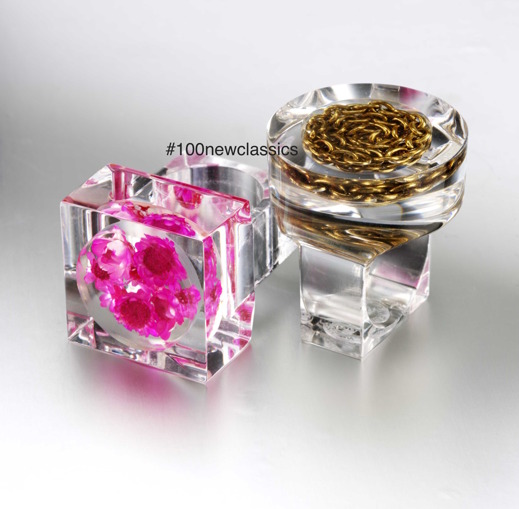I
The Swedish Society of Crafts and Design (Svensk Form) has complied the story of Swedish Design. Questioning the rejection of prominent designers such as Axel Einar Hjorth, G A Berg and Otto Schulz to name a few, alongside other interesting designers, thus seemingly not approved by the Society and subsequently excluded from our Swedish design history. This omission, as well as Svensk Form’s notion of what makes a design classic, made StockholmModern come up with the idea to present “100 New Classics”. Through 2015, starting today, an alternative version, a different take on our Swedish design history and design classics, will be shown on Instagram under the tag 100 new classics. #100newclassics
Siv Lagerström / Acrylic Plastic Rings. Through the late 60s and early 70s, in tune with the political climate of the time, used the low end modern material, acrylic plastic, to challenge the usage and the idea of classic high end materials such as gold, silver and gem stones in jewellery. Lack of interest in her work in Sweden and economic problems put and end to Lagerström´s business in the mid 70s.
Monica Backström’s Rymd / Space collection for Kosta from 1982 was a collection of non usable objects for the ”new age” in an ambiguous meaning. Glass-cylinders of silver, gold and metallic were stacked together to reminiscent rockets or spaceships. Another common reading is that these objects should be seen and used as cousins to the monolith in Arthur C Clarke´s 2001: A Space Odyssey. In the first part of the book (and the film) it suggests that the monolith was instrumental in awakening of intelligence. Backström´s collection however had a slightly smaller but certain impact on parts of the design-collective in the late 80´s and actually still has today.
Sigvard Nilsson and his company, Söwe Konst, were much appreciated in the US and Canada. Nilsson´s company manufactured trays, bowls, spoons and occasionally furniture from pieces of precious Swedish woods, from the late 1950s until Nilssons death in 2007. Early success with modernist teak bowls had Söwe employ up to ten carpenters during its most successful years. The ”ugly” bowls from the Natura collection (1960s-) that still carry all the bark are among the most interesting pieces alongside the rarer tables made from slabs of woods. The best tables bear similarities to those of his contemporary, George Nakashima.
Charlotte Johannesson / “Frei Die RAF”
Behind every great man there is a woman rolling her eyes. Ateljé Cannabis (later Gallery Cannabis) was founded in 1966 by husband and wife, Sture and Charlotte Johannesson. The space was used both as Charlotte’s weaving studio as well as being the meeting place for the Malmö underground in the late 60s. The Swedish art scene during the 60s and 70s was very left winged, but the couple pushed the boundaries, several times, even for the most liberal thinkers. Sture’s art embraced the use of drugs and Charlotte’s craft included pure communist and punk statements. After Sture’s so called Psychedelic Manifest, a collection of six drug related posters, the couple pioneered in digital printing. Charlotte’s weaving was influenced by the early digital graphic aesthetics and her work was far too controversial for the establishment to be considered and recognised. Only a few of her weavings have survived. On view is one of the few pieces remaining: “Frei Die RAF” from 1976. Signed with Social Security Number
Estrid Ericson /Jose Frank Cabinet with Romans Emperors. Estrid Ericson, founder and creative director of Svenskt Tenn ran the daily operations of the company from the 1920s until the mid 1970s when she retired at the age of 81. Her travels, ideas and acquisitions were turned into retail gems in the shape of small boxes, jewellery and furniture. She cut and pasted before the concept was commonly discovered. Pieces by Anna Petrus were put on boxes by Nils Fougstedt while pewter plates by the same Fougstedt were put on tables by Björn Trägårdh. A rare 1900-century book of camellia flowers that Estrid found was cut and applied onto the front of a cabinet. The same happened with old maps, flower plates and historical books. On view a cabinet applied with engravings of Roman Emperors. (Over-) decorated to the sides, top and doors,.
“Demonstration 5 december 2007”, Jacob Dahlgren. In a homage to the Swedish abstract painter Olle Baertling, Jacob Dahlgren staged a demonstration consisting of three hundred participants walking with police escort throughout the streets of Stockholm carrying painted placards, reproductions of Baertling’s paintings. The silent marchers are not seemingly protesting against anything; however, against the backdrop of Stockholm modernist city plans and its roots in social engineering, the demonstration and the abstract art could be considered as a comment upon the democratisation of modern art. I see it as a silent protest against modernist urban planning. Or to quote Mies van Der Rohe “I get up, I sit on the bed. I think, 'what the hell went wrong?’






